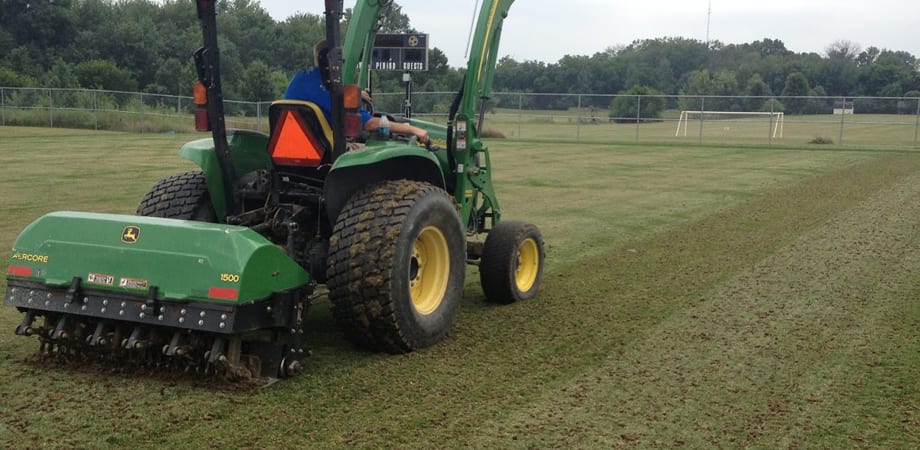Aerification for Sports Turf

Aerification is chiefly important for stopping soil compaction. Soil compaction can hinder or avert oxygen movement into the root zone and the percolation of water. It can also hinder the addition of better mediums and nutrients into the soil profile. All of these issues will, in turn, hurt root growth, making the turf less healthy and less thick than it should be.
Nearly all types of aerification are done mechanically, utilizing either tractor-mounted or self-contained units and the needs of the turf and the soil will dictate the type of aerification required. For instance, use hollow tining for thatch reduction and profile amendment and use venting, deep, needle tining, air and vertical slicing for oxygen and root enhancement.
There are several types of aerfication. There is the traditional hollow tining, which pulls a core, solid tining, needle tining or venting, deep tine aerification, dryject, deep vertical slicing and a new process, which injects air sub surface. The old style, drum-type aerifiers are used from time to time on sports turf, but the use of machines with vertical coring heads, which have the ability to select tine types and hole spacing, have revolutionized the process. The machines with the vertical coring heads are what we are going to focus on in this article.
The most important thing to do before you start to aerify is coming up with an effective aerification program. The first step is to ask yourself, what you are trying to accomplish by aerifying? For instance, are you aerifying to change the soil profile (i.e. – creating a sand cap) The goal you choose will dictate how you aerify. When aerifying to change the soil profile, you will want to use bigger tines.
Another thing to consider before you start creating an aerification program and begin aerifying is the amount of surface area that you want to be affected. Tine size and spacing directly influence the amount of surface area that is impacted. Small tine holes with tight spacing will impact less surface area than larger tine holes with more spacing. For quicker healing and recovery, talk to your ATS sales rep about Foliar-Pak Grow-In.
Best Practices
- Check the condition of your equipment
- Make sure equipment is working properly (needs to be in proper timing)
- Select a tine fitted for the soil conditions
- Consider tine size and spacing on the impact of surface area to be affected
- Consider tine size for healing time (small tine holes will heal quicker than larger holes)
- Clean up and get surfaces back to normal after aerification (remove all the plugs and add topdressing)
- During any type of aerification process, it is an excellent time to overseed.
Best Times to Aerate
Aerifying whenever possible is a good practice, as long as undue stress is not put on the turf. Traditionally, in sport turf hollow tining, spring and fall applications are best. This helps the turf avoid stress, yet encourages quick healing with the higher soil temps. Deep tining is in a similar time. Needle tining or venting is great to do during stressful times on sports turf surfaces.







